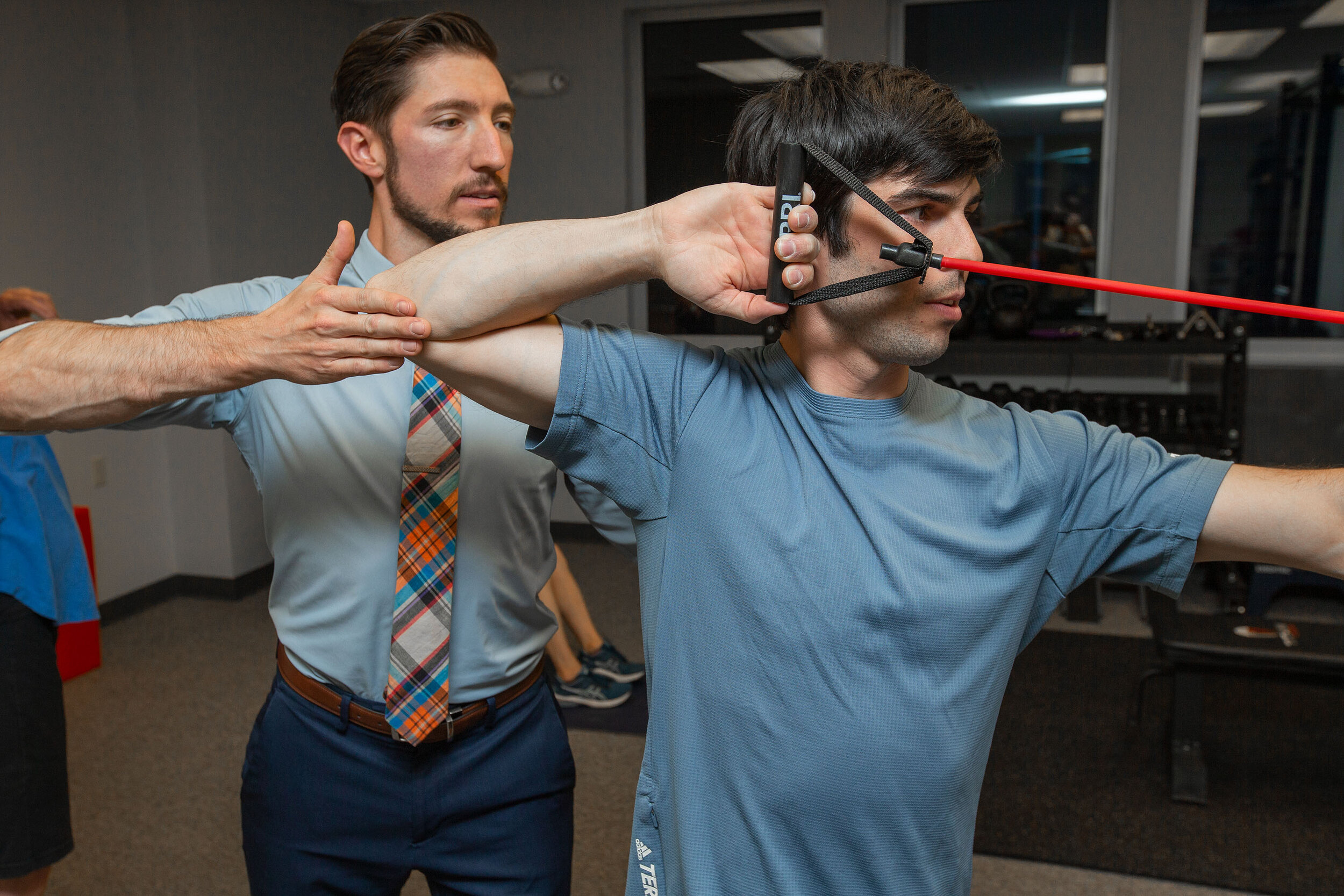Shoulder injuries account for approximately 17% of all climbing-related injuries, making them one of the most common reasons why people seek rock climbing therapy. The shoulder is a complex joint that takes a significant load while climbing, especially as difficulty increases. If you sustain a shoulder injury from climbing, it’s crucial to get the right diagnosis and then follow a treatment plan that is designed specifically for rock climbing movements.
Because of the repetitive nature of climbing, certain patterns of impairments begin to emerge. Many climbers present with muscular tightness to the latissimus dorsi and pectoral muscles, stiffness to the shoulder joints, weakness of the scapular stabilizers and rotator cuff, or stiffness to the thoracic spine joints. All these impairments can be contributing factors to shoulder pain. There are dozens of issues that can cause pain, but the most common rock climbing shoulder injuries are subacromial pain syndrome (also called shoulder impingement), rotator cuff pain, and biceps tendinopathy.
1. Subacromial Pain Syndrome (Shoulder Impingement)
Subacromial pain syndrome occurs when structures within the subacromial space become irritated during shoulder movement. Climbers dealing with this issue often feel discomfort when reaching across their body, performing gaston movements, or pulling with an extended or overhead arm. Pain tends to intensify as fatigue sets in, especially toward the end of a session.
Treatment Approach
Extensive research supports the effectiveness of physical therapy for the shoulder in treating subacromial pain syndrome (1). The most effective approach includes a combination of manual therapy and exercise-based rehabilitation.
- Manual Therapy: Techniques such as thoracic spine manipulation (2), joint mobilizations (3), dry needling, and soft tissue work help reduce pain and restore normal movement patterns. These interventions can speed up recovery and offer muscular shoulder pain relief more effectively than exercise alone.(4)
- Exercise Therapy: A well-structured rehab program focuses on rotator cuff strength, scapular control, and mobility improvements in the shoulder and thoracic spine(5). Exercises should be progressive, challenging enough to build resilience, and designed to withstand the demands of climbing.
2. Rotator Cuff Pain
Rotator cuff injuries develop from excessive strain on the muscles and tendons that stabilize the shoulder. Climbers with rotator cuff pain often experience discomfort when performing repetitive pulling movements, gaston reaches, or dynamic overhang maneuvers. Symptoms may worsen when climbing at high intensity, particularly in bouldering sessions.
Treatment Approach
- Manual Therapy: Techniques like dry needling and trigger point release can help relieve pain and improve function in the affected rotator cuff muscles.(6,7)
- Progressive Strength Training: Building rotator cuff and scapular endurance and strength is critical for long-term recovery. A well-designed rehab program gradually increases loading while reinforcing proper shoulder mechanics.
A comprehensive shoulder physical therapy program in Boulder or Lafayette can address both the immediate pain and the underlying muscular imbalances that contribute to rotator cuff injuries.
3. Biceps Tendinopathy
Biceps tendinopathy results from overuse and chronic stress on the long head of the biceps tendon. Climbers with this condition often feel discomfort when locking off, pulling up, or reaching overhead. Pain sometimes improves during activity but worsens afterward.
Treatment Approach
- Manual Therapy: Joint mobilizations and soft tissue techniques can reduce irritation in the biceps tendon and improve shoulder positioning.
- Strength and Stability Training: Strengthening the rotator cuff and scapular stabilizers helps offload strain from the biceps tendon, reducing irritation and promoting long-term recovery. A structured loading program helps restore tendon health and prevent re-injury.
Injury Prevention: Keeping Your Shoulders Healthy
While treatment is essential for recovery, prevention is the best strategy for avoiding time off the wall. Climbers can reduce their risk of injury by addressing mobility, strength, and movement patterns before issues arise.
Key Prevention Strategies
- Improve Shoulder Mobility: Keeping the thoracic spine, shoulders, and scapulae mobile allows for smoother movement and less compensatory strain.
- Strengthen the Rotator Cuff: A strong rotator cuff provides stability and control, reducing excessive load on other structures.
- Balance Pulling with Pushing: Many climbers overdevelop their pulling muscles while neglecting the antagonist muscles, leading to imbalances. Adding pushing exercises can help maintain joint stability.
- Warm Up Properly: Activating the scapular stabilizers and rotator cuff before climbing can enhance shoulder resilience and reduce strain.
How Long Does Shoulder Rehab Take?
Recovery times vary based on injury severity, adherence to treatment, and individual healing capacity. Here’s a general timeframe for different conditions:
Subacromial Pain Syndrome: 6 to 12 weeks with progressive strengthening
Rotator Cuff Pain: 8 to 16 weeks, depending on severity and tissue healing
Biceps Tendinopathy: 6 to 12 weeks with proper load management
More severe injuries or delays in treatment can extend recovery times. Seeking physical therapy for the shoulder early on can prevent chronic issues and shorten the rehab process.
When to Seek Professional Help
Persistent shoulder pain can signal underlying dysfunction that won’t resolve with rest alone. If you’re experiencing ongoing discomfort, limited mobility, or pain that interferes with climbing, it may be time to seek expert care.
At Mend Colorado, our specialists offer personalized shoulder physical therapy in Boulder and Lafayette, designed specifically for climbers. With a combination of manual therapy, strength training, and movement optimization, we help climbers recover faster and return stronger.
We have lots of free resources available including videos and blog posts to help you better understand your shoulder pain. To get an accurate diagnosis and develop an effective treatment plan, schedule a free consultation with one of the climbing experts at Mend.

